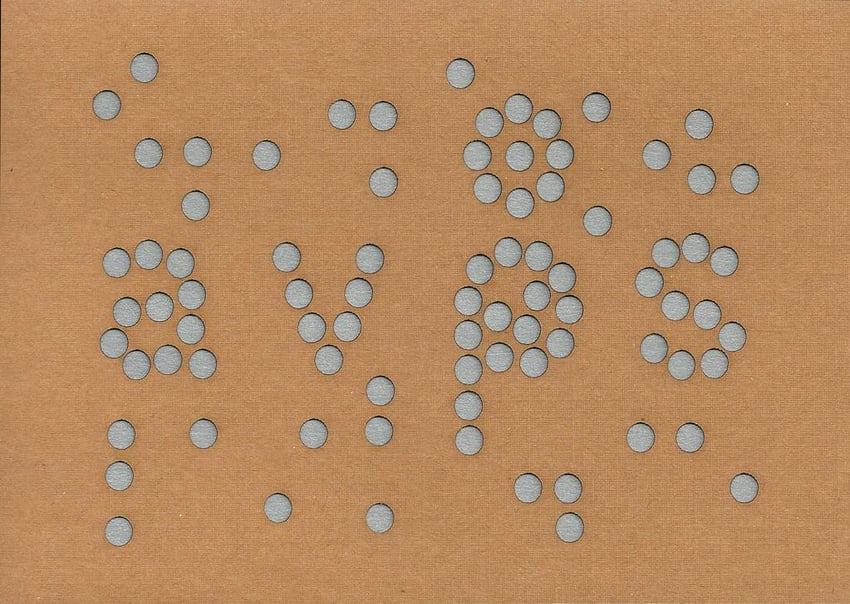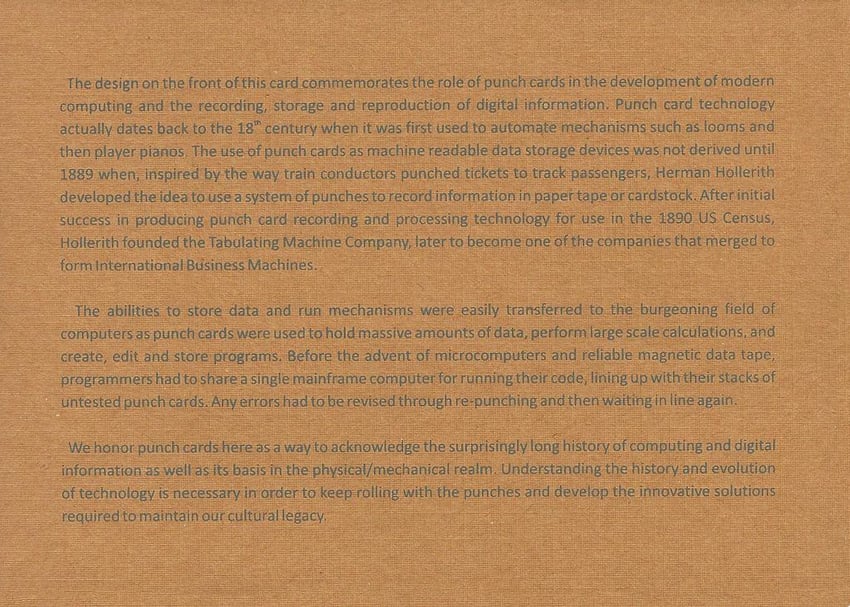AVP Holiday Card – 2010
31 December 2010
Artwork by Stephanie Housley from Coral & Tusk (laser-cut)


All Images on this page are copyright protected and may not be reproduced or used without permission from AudioVisual Preservation Solutions.
Things That Shouldn’t Be Archived #7 — You Decide
24 December 2010
Holiday traditions exist at the crossroads of cultural memory and personal memory (we’ll ignore the confusing cloverleaf interchange of invented memory for now — my holiday gift to you!). What I’ve always found interesting is how these traditions converge and conflict across national, regional, local, and idiosyncratic arenas. For example, my family always had corn at Thanksgiving, and I was surprisingly dismayed and unfulfilled when one year I had Thanksgiving with a friend’s family and they did not have corn, nor did they ever. Or there are Christmas trees which, where I grew up in Oregon could be had for a $5 permit and a thermos of hot chocolate. In New York I see trees starting at $20 per foot (not that an average apartment has all that much space for a very big one). Fake Christmas trees that are re-used every year start to make sense when one considers those kinds of costs.
Holiday songs follow this pattern to a high degree as well. We all had those small handfuls of LPs or cassettes (or CDs for you kids out there) that established the proper version of a song. Maybe this is why it seems that no new holiday songs are any good, but it also makes it very hard to really like a new version of a familiar song. Very much like re-makes of films or adaptations, the “original” (the version first established in our minds) almost always seems better. These kinds of arguments are convenient because of the quickness of a reaction tied to emotion or memory sense, but they are also difficult to articulate because they are often tied to memory. Corn is good and all, but there isn’t a really great reason why it is superior to peas and carrots and why peas and carrots leave a dark hole of sadness within me (but only on the fourth Thursday in November).
With that in mind, I offer up two more recent versions of The Waitresses’ holiday classic “Christmas Wrapping” for your judgement of which should not be archived in our collective memory.
First, the Spice Girls:
Then The Donnas:
You may have an immediate reaction even without listening to these songs based on which commercialized appropriation of feminism you most approve of, but give it a go. There seems to be a balance to successful remakes, covers, adaptations, and new traditions, a balance between capturing something essential about the original and with a creating a different take that opens up new meanings or a new understanding of the original or its contexts. Or maybe it’s just about what makes one shake one’s booty the most.
Happy Holidays!
— Joshua Ranger
Product Process
12 December 2010
Less Process More Product was one of the buzz phrases I heard being bandied about like at AMIA 2010 in Philadelphia. (Other popular phrases included, “xxxxx” and “xxxxxx”.) The concept is certainly valuable, especially as a strategy in finding ways to deal with the massive backlog of backlogged collection processing. However, XXXXXX’s and XXXXXX’s originating article, while looking at the management of 20th century archival collections, is focused specifically on paper materials. We are well familiar with the problematic application to audiovisual materials of paper archival practices or ideologies related to areas such as cataloging rules, storage, arrangement, preservation, etc. As such, it would seem wise to, before subscribing wholesale to a nice turn of phrase, better define what is process and what is product in the archiving of audiovisual materials, what are the minimal levels required to perform each, and where do these and other concepts diverge or converge with practices assigned to paper-based materials.
Know Your Rights
2 December 2010
At the library the other day I picked up the collected Crisis on Infinite Earths, a multi-title crossing mini-series DC Comics put out in 1985 that rebooted its whole universe of characters. (To save face here I’ll have to state that I also checked out McTeague by Frank Norris and a collection of Gogol short stories. So there.) I guess it’s a sign that I’m not a kid reading comic books in the 1980s anymore, but the two most interesting things to me about the series were 1) my amazement at the astonishingly clunky or just lame superhero/villain names, and 2) the fact that The Joker kills Ted Turner stand-in Harold J Standish III in order to steal ownership to his copyrights over colorized silent comedies (which went from worthless to $26million once colorized). It’s always odd to come across a cultural reference like that which was such a flashpoint at the time but which has faded so much in intensity. It really makes me wonder if my memory is correct, if it really was such a big deal or just something that made an impression on my young mind, like the cancelation of Sledge Hammer! or the popularity of Surf Nazis Must Die.
Whatever the case, I remember what a pariah Ted Turner was at that time (Pariah, by the way, is a character in Crisis on Infinite Earths. He was blamed for the destruction of his planet and was forced to watch planetary destruction occur elsewhere, often being blamed by the locals for causing it. See.) for being an uncouth, greedy monster with no cares for history, artistry, and the like.
I found it kind of interesting then when I ran across this article in the Wall Street Journal (“Haven’t I Heard That Song Before?”) about a recent trend of musical artists re-recording their catalogs in order to gain full rights to (the new versions of) their songs. Rather than just getting a percentage of what the rights managing record company earns from sales and licensing, artists such as Carly Simon and Suzanne Vega can take the full cut by distributing versions of their own songs they record with their own investment. The British band Squeeze has gone so far as to re-record their past hits note-for-note, with the stated goal of having film/tv/commercial producers license the Squeeze-owned replica rather than the label-owned one.
Outside of that last, blatantly commercial example, I don’t think many would classify what Carly Simon is doing in the same category as what Ted Turner did — despite how conceptually similar the actions are. American copyright law does not support moral rights as strongly as other nations do, but it is nonetheless something we keenly feel. Simon is remaking her own (to a degree, if one ignores musicians, producers, etc.) creations and Turner was remaking those of others. One may ask, of course, where exactly the droits d’artiste lie with film when there are so many different contributors to a single work. And one may also wonder at the ways in which Turner’s actions converge with the remix culture or with conceptual and performance artists like Sol Lewitt and Marina Abramović who license or allow others to recreate their works. The moral obligation is so often tied up with the emotional connection one experiences with a work of art that the (il)logic of law seems improper to say the least.
This single tangled thread is just another example — as if another were needed — of how the evolution of copyright law has resulted in a creature that resembles the Island of Dr. Moreau more than the Islands of Galapagos. Confusion and uncertainty are the norm when trying to understand the law as written and its various interpretations. That confusion is compounded by the prevalence of formants/versions/instantiations/etc when dealing with audiovisual materials. Placed side-by-side with no documentation (as can often be the case in archives), how would one be able to tell apart an original and a re-recorded Squeeze song in order to determine ownership? If only given an inventory of titles without the ability to listen to the recording, how does one differentiate “Tom’s Diner” from “Tom’s Diner”?
The answer is disarmingly simple in concept though it appears, for a number of reasons, to be difficult in execution of follow through. Sufficient and accessible documentation, strongly defined metadata schemas that are well conformed to, and, in the case of file-based materials, embedded metadata that travels with the digital object can all provide the means necessary for identification and rights assessment.
As much as condition, obsolescence, and valuation, rights have become a defining factor among the variables that drive preservation activities. Organizations that maintain clear rights to content are more likely to allocate resources toward actions that support reuse and re-licensing. Grants often stipulate an end result of preserved materials being made available for access, something not possible without proper rights. By that same token, some granting agencies will not fund reformatting work if ownership is not documented. This isn’t a death knell for orphan works or works with Gordian rights. The same type of documentation can be valuable in authentication of materials, especially in a digital environment, and in the tracking of due diligence efforts when trying to contact possible rights holders before moving ahead with re-use or preservation.
A major impetus behind the Crisis on Infinite Earths series was an attempt to address issues of continuity and the convoluted explanations that had been created to explain shifts in personalities or events that didn’t jibe with what a writer 40 years prior had conceived. The mess of trying to maintain characters and story lines across decades and multiple authors had led to too many Bobby-Ewing-It-Was-All-A-Dream developments, which also made the comics inscrutable to new readers. The DC answer was to cut off the gangrene and hope the limb would grow back all Swamp Thing like. Archivists are my heros, but I’m not sure they have that exact ability. We’ll just have to stick with emulating Organize and Document Man instead.
— Joshua Ranger